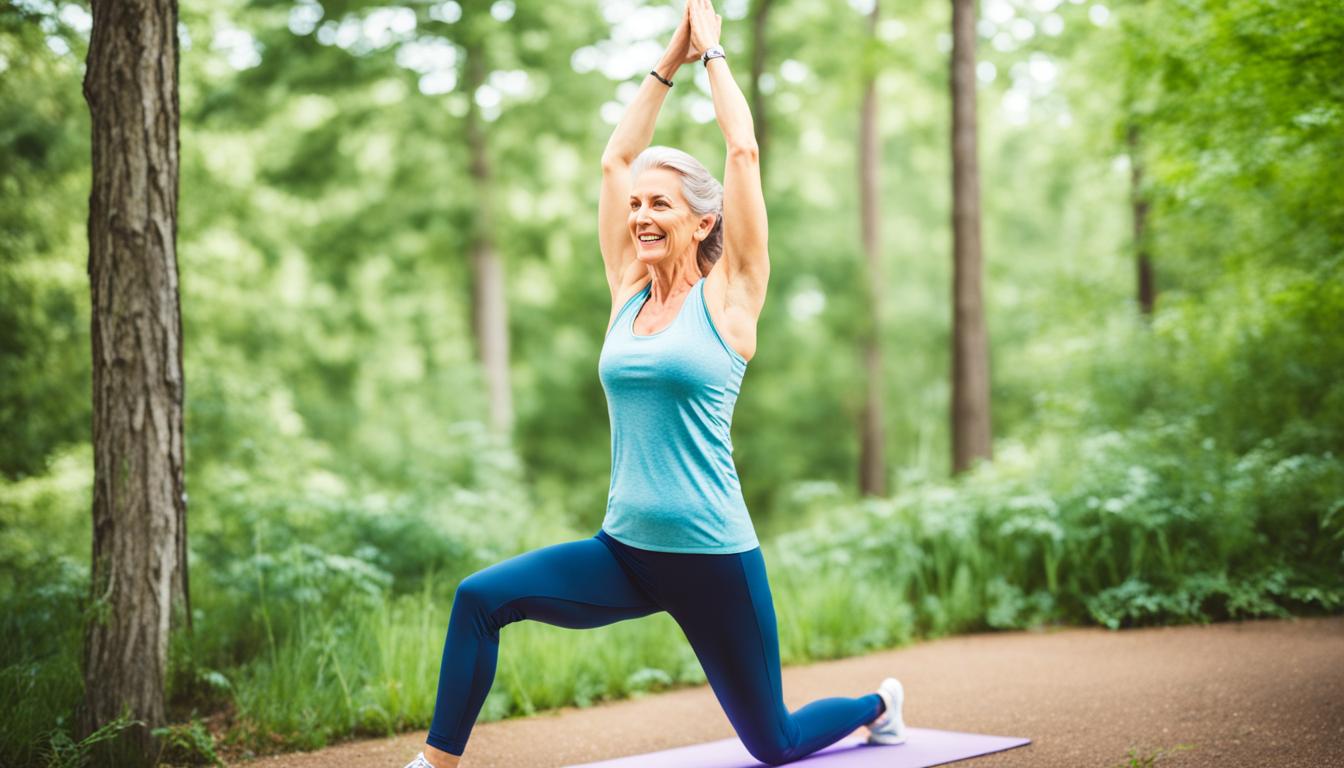Incorporating low-impact exercises into your routine can lead to a healthier lifestyle. These gentle workouts are designed to be effective yet easy on your joints. They are perfect for those with joint issues, arthritis, or recovering from injuries. Activities like walking, swimming, and cycling not only boost cardiovascular health but also improve mobility and overall well-being.
Studies show that low-impact workouts lead to significant improvements in quality of life. For instance, a study found that post-menopausal women with knee osteoarthritis lost weight and improved their walking speed after a four-month aquatic resistance training program. By choosing low-impact exercises, you’re taking a proactive step towards a healthier life while reducing injury risk.
If you’re looking for low-impact cardio activities, check out cardio workouts at home tailored to your needs without putting strain on your body.
Key Takeaways
- Low-impact exercises are ideal for those with joint concerns.
- Gentle workouts can significantly enhance cardiovascular health.
- Incorporating regular low-impact activities can improve overall mobility.
- Popular options include swimming, walking, and cycling.
- Research supports the health benefits of low-impact workouts.
- Choosing joint-friendly exercises allows for safe and effective training.
Understanding Low-Impact Exercise
Low-impact exercise involves activities that put less stress on the joints. It’s a favored choice for many fitness enthusiasts. These workouts ensure one foot remains on the ground, reducing injury risks. Engaging in low-impact fitness routines like walking, swimming, or yoga benefits people of all ages and fitness levels, including seniors.
These exercises enhance endurance and flexibility while maintaining and building muscle mass. They can be easily woven into daily routines. Activities such as brisk walking, biking, and gardening offer great ways to stay active without overstraining. Starting your day with 15 minutes of stretching boosts flexibility and mobility, setting your body up for various activities.
Exercising with a partner can boost your motivation for low-impact workouts. Simple exercises like step-ups, seated hamstring stretches, and single leg stands can be done at home or work. They show that effective low-impact exercises are accessible. If you’re interested in learning more, explore this resource on low-impact workouts to get started.
Benefits of Low-Impact Exercises
Low-impact exercises bring numerous health benefits. They boost heart health and support joint health, fitting various fitness levels. These workouts reduce body stress, enhancing overall well-being and promoting a healthier lifestyle.
Heart Health Improvement
Studies show that low-impact workouts significantly benefit heart health. Walking and swimming offer cardiovascular advantages similar to high-intensity exercises. Regular walking can reduce the risk of high blood pressure, high cholesterol, and heart disease. These activities strengthen the heart and improve circulation over time.
Joint Health and Mobility
Low-impact exercises are key for preserving joint health. They keep individuals active without overloading their joints. Activities like swimming or cycling improve joint flexibility and reduce discomfort, enhancing life quality. These exercises lubricate the joints, aiding those with arthritis or joint issues.
Lower Risk for Diabetes
Low-impact workouts are vital in lowering type 2 diabetes risk. Research indicates that a balanced diet and 150 minutes of moderate-intensity exercise weekly, like brisk walking, can reduce diabetes risk by up to 58%. These exercises aid in weight management and blood sugar regulation for those with diabetes. For more information, visit low-impact exercise benefits.
Effective Low-Impact Exercises You Can Try
Finding the right low-impact workout ideas can greatly improve your fitness while reducing injury risks. Here are two effective options suitable for various fitness levels.
Walking for Fitness
Walking is a highly accessible form of exercise. It aids in weight management, enhances balance, and boosts mood. The American College of Sports Medicine recommends at least 30 minutes of exercise, five days a week for optimal health benefits. You can intensify your walking by increasing speed, distance, or incline for a more challenging workout. Walking is simple, affordable, and ideal for people of all ages.
Swimming for Joint Relief
Swimming is an excellent choice for those looking for a low-impact exercise that’s gentle on the joints. It provides a full-body workout without putting strain on your limbs, making it ideal for those with joint pain. The water’s buoyancy reduces the impact on your body, helping to strengthen muscles and improve cardiovascular health. Adding swimming to your routine can significantly enhance your overall wellness, especially if you find weight-bearing exercises challenging.
Low-Impact Cardio Options
Exploring low-impact cardio options reveals a variety of workouts that boost your heart rate gently. Activities such as cycling, swimming, and walking are favored by those looking for effective yet gentle routines. These exercises enhance cardiovascular health and suit various fitness levels, making them perfect for beginners and experienced athletes alike.

Cycling, whether on a stationary bike or outdoors, is a prime example of low-impact cardio. It helps reduce joint pain and strengthens muscles, especially for those with osteoarthritis. A 155-pound person can burn around 252 calories in 30 minutes cycling at a moderate pace.
Swimming is a “no impact” workout that engages the full body. It minimizes joint stress and provides a thorough aerobic workout. A 155-pound person can burn about 216 calories in half an hour of swimming. This exercise boosts endurance and flexibility, making it a wise choice for any low-impact routine.
Walking is not just a practical option but also a mental health booster. Fast-paced walking can burn about 175 calories for a 155-pound person in 30 minutes. This activity lowers the risk of depression, enhancing overall well-being.
Rowing is another excellent low-impact cardio choice. It works multiple muscle groups and enhances fitness markers. A study revealed that rowing aids in body composition, muscle endurance, and flexibility. A 155-pound person can expect to burn about 252 calories in 30 minutes of rowing at a moderate pace.
Incorporating these low-impact cardio options into your routine can significantly boost your fitness journey while reducing injury risk. Engage in these activities regularly to enjoy their numerous physical and mental benefits.
Incorporating Strength Training Into Low-Impact Routines
Low-impact strength training is essential for a well-rounded fitness plan. It boosts your strength while easing the strain on your body. Exercises like bodyweight squats, hip bridges, and lunges are ideal. Perform these exercises 2-3 times a week for best results.
Begin with lighter weights or resistance bands to ease into the routine. This method suits everyone, from novices to those with joint concerns. Focusing on proper form over the weight lifted reduces injury risks like sprains and strains.
Adding exercises like the single-arm dumbbell row and dumbbell chest press enhances muscle strength and supports joint health. These movements help maintain bone density, crucial for preventing osteoporosis.
Engaging in these low-impact workouts not only builds muscle but also elevates your metabolism and enhances overall health. High-intensity, low-impact exercises challenge your body safely, making your fitness journey both successful and secure.
Popular Low-Impact Activities to Try
Adding low-impact exercises to your daily routine can be both fun and beneficial for your health. Consider trying yoga, Pilates, barre classes, and tai chi. These activities focus on core strength, flexibility, and balance. They are easy on the joints and support overall wellness.
Aqua classes are a great choice. The water’s resistance offers a full-body workout, helping with weight loss and muscle gain while easing joint stress. Group cycling is another excellent aerobic exercise. It boosts fitness without overstraining your body. Both options let you stay active while lowering injury risks.
Golf is another low-impact activity that’s both enjoyable and beneficial. Walking the course offers a social experience and improves core strength and stamina. Badminton and walking football also provide chances to socialize and compete in a friendly manner.
For beginners, walking is a great place to start. Aim for 8,000 to 10,000 steps a day to gradually increase your fitness. Swimming is another excellent choice. It provides joint relief and muscle building benefits, suitable for all fitness levels.
Concluding, mixing up your fitness routine with low-impact activities can help prevent boredom and offer numerous health benefits. By trying different exercises, you can find what suits you and your lifestyle best.
Building a Low-Impact Exercise Routine
Creating a consistent low-impact exercise routine demands careful planning and commitment. Begin by assessing your current fitness level. Select a mix of low-impact workout ideas that match your interests, ensuring they keep you engaged. Aim for at least 150 minutes of moderate-intensity exercise each week, focusing on a variety of exercises to work different muscle groups. This approach not only keeps you motivated but also boosts your overall fitness.
Consider adding a 20-minute low-impact cardio circuit to your routine. This circuit features six exercises, each lasting one minute. Doing this circuit three times offers a thorough workout. Exercises like low-impact jumping jacks and standing oblique crunches are ideal for those with bad knees or hips, or those feeling fatigued. You can adjust the exercises based on your fitness level and take breaks when necessary. Always heed your body’s signals and stop if you experience discomfort.
The main aim of this circuit is to enhance cardiovascular endurance and strength without the high-impact risks. Moreover, the Physical Activity Guidelines for Americans suggest strength training twice a week for adults. Low-impact exercises are crucial for post-injury recovery, helping to prevent the significant risk of re-injury from poorly managed conditions.
For those looking for alternatives, activities like cycling, swimming, and rowing are excellent choices. Tools like the LIT Strength Machine offer over 500 low-impact exercises for home workouts. The Mayo Clinic advocates for low-impact strength training, stating it improves muscle growth and joint stability. With versatile options such as the LIT Axis strength training band, adjustable up to 200lbs, you can easily integrate low-impact exercises into your routine.
Safe Practices for Low-Impact Workouts
Engaging in safe low-impact exercises ensures you enjoy benefits without risking injury. Walking is a top choice for all ages and fitness levels. It’s accessible and easy to fit into your routine, focusing on injury prevention.
For those with conditions like arthritis or osteoporosis, staying active is crucial. *Staying active is one of the best things you can do for your joints and bones.* Swimming is a great choice for a full-body workout that’s easy on the joints. *Swimming provides a full-body workout while taking pressure off your joints,* making it a safe option.
Yoga can also elevate your fitness journey. It boosts mental health and physical fitness with poses and breathing exercises. *Yoga can improve your mental health and physical fitness through a series of poses and breathing exercises.* As you get more comfortable, gradually increase the resistance or weight, as fitness expert Gallardo suggests. *Start slowly, and gradually increase the resistance or weight as the exercises feel easier.*
Low-impact workouts are gaining popularity among fitness enthusiasts. They’re easier on the joints, allowing for more frequent workouts with less recovery time. This lets beginners learn proper form before moving to higher intensity.
Adding safe low-impact exercises to your routine can round out your fitness plan. Use equipment like resistance bands, stationary bikes, and rowing machines to boost intensity without heavy weights. Don’t forget to try Pilates and dance cardio to keep your body engaged.

The Future of Low-Impact Fitness
The fitness landscape is undergoing a significant transformation, with low-impact exercise trends at the forefront. These trends are reshaping how we view our exercise routines. Over a third of American adults now prefer low-intensity training, signaling a shift towards sustainable health and wellness. This shift prioritizes joint health and overall well-being.
Pilates is a leading force in this evolution, emphasizing balance, flexibility, and core strength. It transcends traditional workouts, becoming a lifestyle choice that benefits both physical and mental health. The focus on “functional fitness” is gaining traction, with exercises designed to prepare the body for everyday tasks. Platforms like Jukestir are responding to this trend, offering accessible, effective low-impact routines.
Looking ahead, low-impact exercises provide a comprehensive approach to fitness. They minimize injury risks and make exercise accessible to people of all ages and abilities. By choosing low-impact workouts, you enhance strength and cardiovascular fitness while placing less strain on your body. The future of low-impact fitness, with modalities like Pilates, looks promising for those seeking balance and well-being.
FAQ
What are low-impact exercises?
Who can benefit from low-impact workouts?
What are some effective low-impact cardio options?
How can low-impact exercises improve heart health?
Can low-impact exercises help with weight management?
What are the benefits of low-impact strength training?
How often should I incorporate low-impact exercises into my routine?
Are there any safety concerns with low-impact exercises?
What popular low-impact activities can I try?
Source Links
- What Are the 12 Best Low-Impact Exercises? – https://www.health.com/fitness/low-impact-workouts
- Low-Impact Workouts: What They Are, Health Benefits, and Getting Started – https://www.everydayhealth.com/fitness/low-impact-workouts/guide/
- What Is Low-Impact Exercise? | Cigna Healthcare – https://www.cigna.com/knowledge-center/what-is-low-impact-exercise
- High-Impact and Low-Impact Exercise – Medical Associates of Northwest Arkansas – https://mana.md/high-impact-and-low-impact-exercise/
- 5 Benefits of Low-Impact Exercise | Grady Health – https://www.gradyhealth.org/blog/5-benefits-of-low-impact-exercise/
- What to Know About Low-Intensity Workouts – https://www.webmd.com/fitness-exercise/what-to-know-low-intensity-workouts
- Looking for a Minimal Stress Workout? Try Low-Impact Exercise – https://www.verywellhealth.com/low-impact-exercise-5216089
- 21 Low Impact Cardio Ideas – https://greatist.com/fitness/take-it-easy-21-unexpected-low-impact-workouts
- 10 Types of Low Impact Cardio That Come With Major Health Benefits – https://www.onepeloton.com/blog/low-impact-cardio/
- 5 Low Impact Cardio Exercises That Burn Fat – https://www.healthline.com/health/fitness-exercise/low-impact-exercises
- 8 Low-Impact Cardio Moves to Add to Your Workout Routine – https://www.health.com/fitness/cardio-workouts/low-impact-cardio
- Your Guide to Low Impact Strength Training | Method Gym – https://methodgym.com/your-guide-to-low-impact-strength-training/
- What Is a High Intensity, Low Impact Workout? – https://true40studio.com/blog/the-workout/what-is-a-high-intensity-low-impact-workout
- 10 Top Low Impact Exercises you Need to try – Everyone Active – https://www.everyoneactive.com/content-hub/fitness/low-impact-exercises/
- Trainers Want You to Try These Low-Impact Cardio Workouts – https://www.prevention.com/fitness/workouts/a60597573/low-impact-cardio/
- 12 Low-Impact Workouts That Really Pay Off – https://www.henryford.com/blog/2019/10/12-effective-low-and-no-impact-activities
- You Can Do This Low-Impact Cardio Workout in 20 Minutes – https://www.healthline.com/health/fitness-exercise/low-impact-cardio
- Low Impact Strength Training: The Complete Guide With Workouts – https://www.litmethod.com/blogs/boltcut-blog/low-impact-strength-training
- Stay active with 6 low-impact workouts – https://healthy.kaiserpermanente.org/health-wellness/healtharticle.6-low-impact-workouts
- Your Complete Guide to Low-Impact Workouts – https://www.shape.com/low-impact-workouts-6544218
- The Evolution of Fitness: Embracing Low-Impact Workouts for Long-Term Health – https://jukestir.com/blogs/news/the-evolution-of-fitness-embracing-low-impact-workouts-for-long-term-health
- Why low-impact workouts like Pilates are the future of fitness – https://unitehealth.com.au/blog/low-impact-workouts-like-pilates-are-the-future-of-fitness
- The Truth About Low Impact Workouts (and Why They Work!) | Team Body Project – https://teambodyproject.com/exercise/the-truth-about-low-impact-workouts-and-why-they-work/


